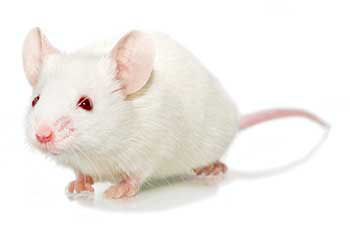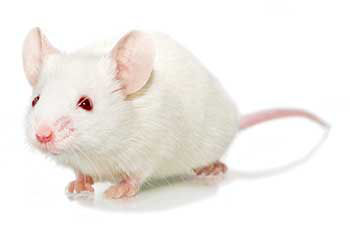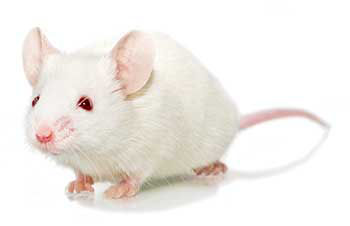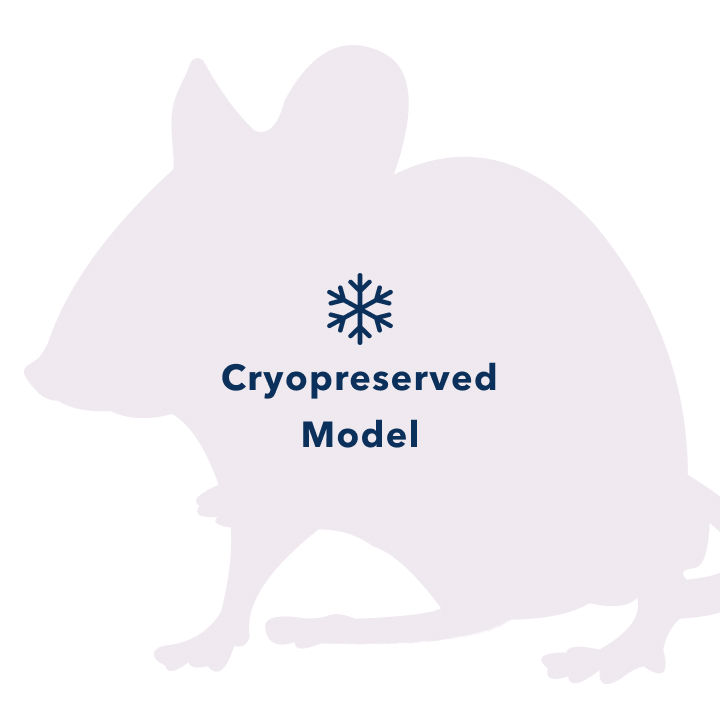| Model No. | Nomenclature | Genotype |
|---|---|---|
| 2767-F | FVB.129P2-Abcg2tm1Ahs N7 | ko/ko |
| 2767-M | FVB.129P2-Abcg2tm1Ahs N7 | ko/ko |
Bcrp
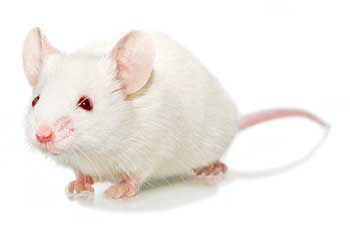
- Description
- Related Products & Services
- Price & Licensing
- Health Report
- Overview
- Genetics
- Guides & Publications
- Applications & Therapeutic Areas
- Transit, Housing & Welfare
- Diet
Overview
Nomenclature: FVB.129P2-Abcg2tm1Ahs N7
- Carries a disruption of the Abcg2 gene (ATP-binding cassette, sub-family G, member 2), formerly referred to as Bcrp
- Altered drug transport capabilities due to ABC transporter protein deficiency
- Bcrp functions as an efficient pharmacological barrier expressed in the apical membrane of epithelial cells of the small intestine, colon, cecum, and renal proximal tubules, in hepatic bile canalicular membranes, in mammary gland alveolar epithelial cells during pregnancy and lactation, and in placental labyrinth cells
- Bcrp actively transports various anticancer drugs causing multi-drug resistance when expressed in cancer cells
- Homozygote develops phototoxicity upon exposure to pheophorbide a, a chlorophyll metabolite, first expressed as ear lesions and can progress to mice becoming moribund
- Homozygotes also displays a novel type of protoporphyria characterized by elevated levels of protoporphrin IX
- Useful for studies of ATP-dependent transporters in vivo drug disposition and in inflammatory studies
Recommended Controls
The recommended control for this model is FVB/NTac.
Origin
The Bcrp mouse was developed in the laboratory of Alfred Schinkel of the Netherlands Cancer Institute in 2002. The model was created by targeting the Abcg2 gene in E14 embryonic stem cells derived from 129P2/OlaHsd mice and injecting the targeted cells into FVB blastocysts. Resultant chimeras were backcrossed to FVB/N for seven generations (N7). Taconic received stock in July 2003. The mice were derived by embryo transfer and are maintained by incrossing of homozygous mice.
Genetics
Guides & Publications
Initial Publication:
Jonker JW, Buitelaar M, Wagenaar E, Van Der Valk MA, Scheffer GL, Scheper RJ, Plosch T, Kuipers F, Elferink RP, Rosing H, Beijnen JH, Schinkel AH. (2002) The breast cancer resistance protein protects against a major chlorophyll-derived dietary phototoxin and protoporphyria. Proc Natl Acad Sci USA, 99(24):15649-54.
Applications & Therapeutic Areas
- ADMET
- Oncology & Immuno-Oncology
- Safety Assessment
Transit, Housing & Welfare
Need more info? Click the live chat button or Contact Us
Packing Practices
Taconic standard practice is to recombine animals of different home cages and/or ages from a single model and sex during packing, except in specific cases where Taconic's animal welfare policy prohibits recombination due to aggression or other concerns. When an order is fulfilled with animals from more than one week of birth, this standard practice results in animals from a range of birth weeks packed together in a single TTC. When an order is fulfilled with animals from genotyped models, this standard practice results in animals from different home cages packed together in a single TTC.
Customers who wish to keep animals from different weeks of birth separated should place orders with the special instruction "Divide and label by age." Note that this special request can result in increased costs for additional Taconic Transit Cages, dividers and/or freight charges.
Taconic discourages other types of custom packing requests as they can have a negative impact on animal welfare. Learn more.
Diet
- Services
- Licensing
- Pricing - USD
- Pricing - EUR
- Pricing - DKK
- Pricing - USD Nonprofit
- Pricing - EUR Nonprofit
- Pricing - DKK Nonprofit
- Select my Health Standard
- Get Custom Pricing Guide
Bcrp
Conditions of Use for Taconic Transgenic Models™
Taconic Transgenic Models™ (Models) are produced and distributed under rights to patents and intellectual property licensed from various institutions. Taconic sells the Models to purchasers, grants to each purchaser a right under Taconic's rights in such licensed patents and intellectual property to use the purchased Model in consideration of purchasers' acknowledgement of and agreement to the Terms and Conditions for Taconic Models, Products and Services and the following terms of use:
- Title to these Models and biological materials derived from them remains with Taconic.
- The Models will be used for research purposes only.
- The Models will not be bred or cross-bred except to obtain embryos or fetuses required for research purposes unless additional rights have been granted in writing by Taconic.
- The Models and biological materials derived from them will not be distributed to third parties or used for commercial purposes.
- Non-profit purchasers may not use this Model and/or biological materials derived from it in sponsored research or contract research studies unless it is purchased at the for-profit price.
Pricing - USD
Murine Pathogen Free (MPF) Health Standard
2767 Female
2767-F Genotype ko/ko
Cohorts are reserved upon order placement and will take 2-4 weeks to fulfill. An estimated lead time will be provided to you within 2-3 business days.
| Age in Weeks | Quantity 1 - 999 |
|---|---|
| 3 to 10 | US$396.00 |
2767 Male
2767-M Genotype ko/ko
Cohorts are reserved upon order placement and will take 2-4 weeks to fulfill. An estimated lead time will be provided to you within 2-3 business days.
| Age in Weeks | Quantity 1 - 999 |
|---|---|
| 3 to 10 | US$396.00 |
Pricing - EUR
Murine Pathogen Free (MPF) Health Standard
2767 Female
2767-F Genotype ko/ko
Cohorts are reserved upon order placement and will take 2-4 weeks to fulfill. An estimated lead time will be provided to you within 2-3 business days.
| Age in Weeks | Quantity 1 - 999 |
|---|---|
| 3 to 10 | 360,00 € |
2767 Male
2767-M Genotype ko/ko
Cohorts are reserved upon order placement and will take 2-4 weeks to fulfill. An estimated lead time will be provided to you within 2-3 business days.
| Age in Weeks | Quantity 1 - 999 |
|---|---|
| 3 to 10 | 360,00 € |
Pricing - DKK
Murine Pathogen Free (MPF) Health Standard
2767 Female
2767-F Genotype ko/ko
Cohorts are reserved upon order placement and will take 2-4 weeks to fulfill. An estimated lead time will be provided to you within 2-3 business days.
| Age in Weeks | Quantity 1 - 999 |
|---|---|
| 3 to 10 | kr.2.678,00 |
2767 Male
2767-M Genotype ko/ko
Cohorts are reserved upon order placement and will take 2-4 weeks to fulfill. An estimated lead time will be provided to you within 2-3 business days.
| Age in Weeks | Quantity 1 - 999 |
|---|---|
| 3 to 10 | kr.2.678,00 |
Pricing - USD Nonprofit
Murine Pathogen Free (MPF) Health Standard
2767 Female
2767-F Genotype ko/ko
Cohorts are reserved upon order placement and will take 2-4 weeks to fulfill. An estimated lead time will be provided to you within 2-3 business days.
| Age in Weeks | Quantity 1 - 999 |
|---|---|
| 3 to 10 | US$396.00 |
2767 Male
2767-M Genotype ko/ko
Cohorts are reserved upon order placement and will take 2-4 weeks to fulfill. An estimated lead time will be provided to you within 2-3 business days.
| Age in Weeks | Quantity 1 - 999 |
|---|---|
| 3 to 10 | US$396.00 |
Pricing - EUR Nonprofit
Murine Pathogen Free (MPF) Health Standard
2767 Female
2767-F Genotype ko/ko
Cohorts are reserved upon order placement and will take 2-4 weeks to fulfill. An estimated lead time will be provided to you within 2-3 business days.
| Age in Weeks | Quantity 1 - 999 |
|---|---|
| 3 to 10 | 360,00 € |
2767 Male
2767-M Genotype ko/ko
Cohorts are reserved upon order placement and will take 2-4 weeks to fulfill. An estimated lead time will be provided to you within 2-3 business days.
| Age in Weeks | Quantity 1 - 999 |
|---|---|
| 3 to 10 | 360,00 € |
Pricing - DKK Nonprofit
Murine Pathogen Free (MPF) Health Standard
2767 Female
2767-F Genotype ko/ko
Cohorts are reserved upon order placement and will take 2-4 weeks to fulfill. An estimated lead time will be provided to you within 2-3 business days.
| Age in Weeks | Quantity 1 - 999 |
|---|---|
| 3 to 10 | kr.2.678,00 |
2767 Male
2767-M Genotype ko/ko
Cohorts are reserved upon order placement and will take 2-4 weeks to fulfill. An estimated lead time will be provided to you within 2-3 business days.
| Age in Weeks | Quantity 1 - 999 |
|---|---|
| 3 to 10 | kr.2.678,00 |
Select my Health Standard
Need help choosing the right Taconic Biosciences health standard for your research?
Use the Health Standard Selector to enter your exclusion list. The tool will tell you which health standards meet your requirements.
Get custom pricing guide
Schedule A Scientific Consultation
Connect directly with a member of our Scientific Solutions team who can help you select the most appropriate model and maximize your experimental success.
















.jpg)

.jpg)
.jpg)
.jpg)
.jpg)





.jpg)


.jpg)
.jpg)




.jpg)




.jpg)

.jpg)





